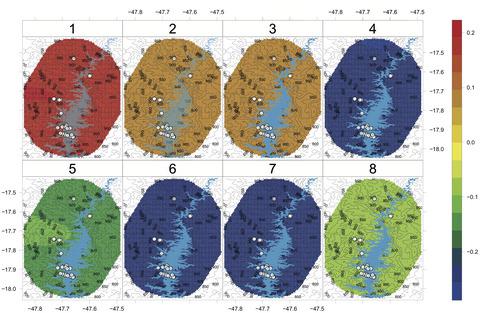当前位置:
X-MOL 学术
›
J. Appl. Ecol.
›
论文详情
Our official English website, www.x-mol.net, welcomes your feedback! (Note: you will need to create a separate account there.)
River dams and the stability of bird communities: A hierarchical Bayesian analysis in a tropical hydroelectric power plant
Journal of Applied Ecology ( IF 5.7 ) Pub Date : 2020-04-13 , DOI: 10.1111/1365-2664.13607 Tarcísio L. S. Abreu 1 , Sandro B. Berg 1 , Iubatã P. Faria 2 , Leonardo P. Gomes 1 , Jader S. Marinho‐Filho 1 , Guarino R. Colli 1
中文翻译:

河流水坝与鸟类群落的稳定性:热带水力发电厂中的贝叶斯层次分析
更新日期:2020-04-13
Journal of Applied Ecology ( IF 5.7 ) Pub Date : 2020-04-13 , DOI: 10.1111/1365-2664.13607 Tarcísio L. S. Abreu 1 , Sandro B. Berg 1 , Iubatã P. Faria 2 , Leonardo P. Gomes 1 , Jader S. Marinho‐Filho 1 , Guarino R. Colli 1
Affiliation

|
- The effects of anthropogenic disturbance upon the stability of wildlife communities depend on the heterogeneity and connectivity of habitat remnants on multiple scales. The number of hydroelectric dams in biodiversity hotspots (Africa, South America and Asia) is growing rapidly. To establish their environmental impact, it is essential to understand the dynamics of wildlife communities before and following the establishment of dams.
- We evaluated the impacts of the filling of the Serra do Facão hydroelectric reservoir in the São Marcos river, central Brazil, on the bird community. Using data from 1,145 surveys across 20 sampling sites over 8 years, 2 years before and 6 years after the filling of the reservoir, we assessed the resistance, i.e. maintenance close to an equilibrium state during the disturbance, and resilience, i.e. ability to return to the original state following the disturbance, of the bird community. We used spatiotemporal hierarchical Bayesian models to assess the effects of reservoir filling on five community parameters: abundance, richness, phylogenetic diversity, functional diversity and species composition.
- In the period subsequent to reservoir filling, there was (a) a marked reduction in bird abundance, richness, phylogenetic diversity and functional diversity, and (b) a reduction in the proportion of forest species, coupled with an increase in the proportion of savanna species. Except for bird abundance, none of the other community attributes returned to their original levels, even after 6 years. Our findings indicate that Cerrado bird communities have both low resistance and low resilience to habitat loss associated with the establishment of hydroelectric reservoirs.
- Synthesis and applications. The environmental costs of hydroelectric dams are still underestimated or neglected in Brazil. A new paradigm in the assessment of their environmental impacts is warranted, incorporating (a) models of spatiotemporal variations based on long‐term monitoring with surveys initiated before disturbances and (b) measures of functional and phylogenetic diversity, such that society can understand the costs and benefits of the establishment of new hydroelectric dams and make informed decisions. Biodiversity loss could be minimized by ensuring the preservation and connectivity of alluvial habitats, capable of maintaining the supply of resources and the functional and phylogenetic attributes of bird communities associated with such habitats.
中文翻译:

河流水坝与鸟类群落的稳定性:热带水力发电厂中的贝叶斯层次分析
- 人为干扰对野生动植物群落稳定性的影响取决于多种规模的栖息地残余物的异质性和连通性。生物多样性热点地区(非洲,南美和亚洲)的水力发电大坝数量正在迅速增长。为了确定它们对环境的影响,在修建水坝之前和之后,必须了解野生动植物群落的动态。
- 我们评估了巴西中部圣马可斯河中的Serra doFacão水电站水库充填对鸟类群落的影响。利用在水库注水前8年,2年和6年后20个采样点进行的1,145次调查的数据,我们评估了阻力(即在扰动期间保持接近平衡状态)和复原力(即恢复到水位的能力)。鸟类群落受到干扰之后的原始状态。我们使用时空分层贝叶斯模型评估储层充填对五个群落参数的影响:丰度,丰富度,系统发育多样性,功能多样性和物种组成。
- 在水库充填之后的时期,(a)鸟类的丰度,丰富度,系统发育多样性和功能多样性显着减少,(b)森林物种的比例减少,热带稀树草原的比例增加种类。除了鸟类数量丰富之外,其他所有社区属性即使在6年后也没有恢复到原始水平。我们的发现表明,塞拉多鸟类群落对与水力发电水库建立相关的栖息地丧失的抵抗力和复原力均较低。
- 综合 与 应用。在巴西,水力发电大坝的环境成本仍然被低估或忽略。在评估其环境影响方面,需要一种新的范式,其中包括:(a)基于长期监测的时空变化模型和在干扰发生之前进行的调查,以及(b)功能和系统发育多样性的度量,以便社会能够理解成本建立新的水力发电大坝的好处和做出明智的决定。通过确保冲积生境的保存和连通性,能够维持资源供应以及与这些生境相关的鸟类群落的功能和系统发育特性,可以使生物多样性的损失最小化。


























 京公网安备 11010802027423号
京公网安备 11010802027423号